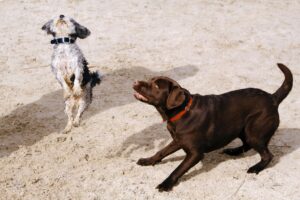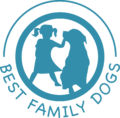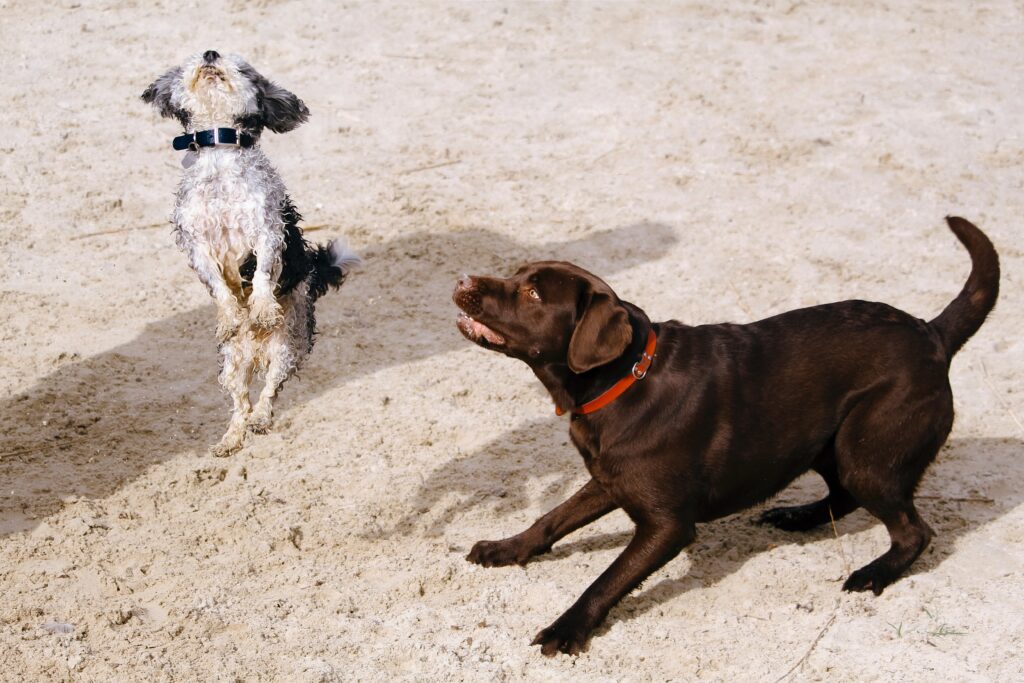Dog Play Behavior
We've all watched dog play before. Do you think big dogs or little dogs are more likely to roll over into submissive positions?
Dogs communicate through body language. Dogs learn how to communicate with other dogs starting within their first week of life! Exploring dog socialization and play behavior is a rapidly growing area of animal behavior studies.
We know that puppies get their first canine social cues from their littermates and mother. Puppies continue to grow and learn rapidly for the first 7 weeks of their life. The canine behavior skills they learn are meant to last a lifetime.
Most puppies are adopted around 8 weeks of age. This is a transitional phase where their ability to communicate canine-canine may experience some unintentional interruption as puppies adapt to their new human family. During this time, they need veterinary checks and vaccinations. It is a very busy time. Families with new puppies often set priorities which exclude forming new relationships with other dogs in their neighborhood for the initial adjustment phase.
How did you keep your puppy socializing safely with other dogs at a very early age?
“…when (puppies) eyes open, until they go to their own homes, they spend almost all of their waking hours wrestling with each other.”
— American Kennel Club (AKC) Author, May 2019
Good Dog Play Behavior: What Does it Look Like?
Every dog owner wants their dog to have a happy, successful play experience with other dogs.
However, it can be challenging to determine healthy play behavior in the canine species. Chasing, biting, pouncing sound like things dogs might do as they play, but how can the observing human know if it is signs of enjoyment or not?
Here are 4 ways dogs play that are happy and healthy.
- Play Pawing
- Play Pause
- Bit Inhibition
- Submissive: Safe Play

Play Pawing: Dogs Encourage Role Play
Dogs like to tease and call attention to themselves during play. After all, play has to be initiated by one and accepted by the other.
One of the ways dogs can communicate with a canine peer they are ready to play is through the commonly recognized “play bow”.
In my opinion, the play bow is the most common behavior understood by professionals and owners, alike. The canine play bow is the most obvious sign of friendliness and readiness-to-engage in play.
The next level is play pawing. Play pawing is the canine equivalent to human “tag”, essentially – “you’re it!”. This is how dogs experience turn taking, and role reversal.
When you think about the dynamics of the game “tag”, you will notice that once tagged, the person is “it”, and turns to chase the other person. This simple game of chase is very popular with dogs. And if you watch, you will notice they do take turns chasing each other.
Turn taking and role reversal allows dogs to expand their play experience by safely exploring joy and risk. By pushing boundaries and maintaining acceptance in the peer relationship.
In an urban environment, play pawing allows dogs to temporarily let go of their learned socialization of our human world and revert back to their canine qualities. Dogs gain a sense of “pack“ acceptance, and the thrill of the raw challenges of the wild! Dogs use play pawing to maintain peer engagement and encourage chase-based play and thrill of the hunt.

Play Pause: Dog Checks If The Other Dog is Having fun
The play pause is another play behavior that dogs use in healthy canine-canine interaction. This play pause may be brief or long. It is a chance for each dog to check in with the other. They decide, if they are going to continue to play the game, if they are both still interested; and they take a moment to catch their breath after they have been going all out!
Bit Inhibition: Dogs Practice Gratification Control
Play biting is a very specialized social skill for dogs. Dogs use their mouth like humans use their hands. Mother dogs mouth their babies to pick them up and carry them. In this behavior they use a “soft mouth”, a gentle hold bite, that is not meant to hurt the puppy.
As puppies learn canine social cues they learn that biting isn’t just for food, but also for play. The challenge of mastering the play bite is to have a hold that is firm but soft simultaneously. Firm enough to grip gently, but not firm enough to hurt. And the real challenge for some more aggressive breeds like hunting or sporting dogs is to not get carried away! Active breeds need to be aware of the context of the bit during play and not get aggressive. The play bite can be easily misinterpreted by human observers.
The human observer can see that a dog with relaxed, “bouncy”, body language is having fun. A dog with stiff body language and barred teeth and growling is saying “I’ve had enough”, and is at risk of going beyond the play bite.

Soft, Submissive Play: Strategized Defense
Traditionally, humans have interpreted dogs rolling over in play as a submissive “game over” reaction. New research indicates that although this may be true in some circumstances, it has also been found as a strategic defense by the dog who rolls supine.
Dogs have been observed to roll over in play as an act of defense, rather than submission for themselves. To avoid bit inhibition from the canine playmate.
Dogs have also shown that they can play-paw or lunge from this supine position, with the advantage of getting at the vulnerable spots of their play opponent. Often placing paws or mouths on their play opponent’s neck, chest or belly as approached from underneath.
Rolling over isn’t simply giving up or giving in. It depends on the dogs, what behaviors came before, and what behaviors continue after.
“well-socialized dogs are more secure, confident and self-assured.”
— Dr. R.K. Anderson DVM, 2023
Support Healthy Dog Play
Now you know four healthy dog play behaviors and what they mean. Keep your dog or puppy socializing with other dogs when the opportunities arise! Remember the behaviors play-pawing, play pause, bit inhibition and calm submission. How many play behaviors can you observe when your dog plays?

Canine Fitness Month Resources:
Canine Fitness Month “Pawsitive Choices”

